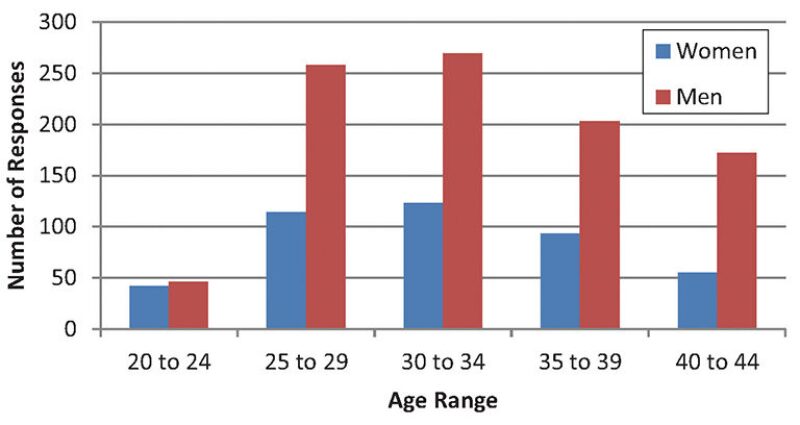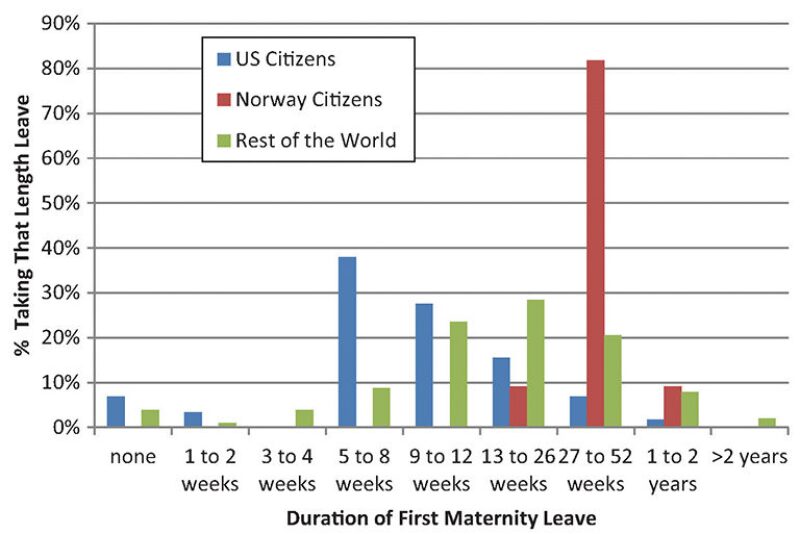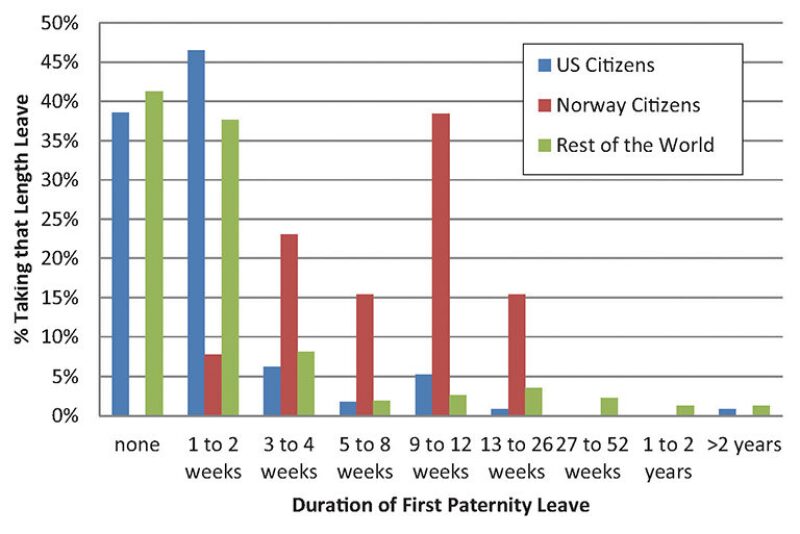A survey of SPE’s membership conducted in May 2011 by the SPE Talent Council showed that dual-career couples comprise about half the petroleum engineering workforce (Sprunt and Howes 2011a, b). In many of those couples, each partner contributes between 40% and 60% of the household income. Situations that jeopardize the employment of one partner are a major financial consideration. Two significant challenges for dual-career couples are relocation and childrearing.
To better understand the challenges facing dual-career couples, in December 2011, the SPE Talent Council surveyed SPE members under age 45. A more detailed report of the survey is available in paper SPE 160928 (Sprunt and Howes 2012). The survey had a 5% response rate, down from the 12% response rate of the prior survey. Responses were received from 1,392 people, 31% of whom are female. The age distribution of those responding is shown in Fig. 1. Of those responding, 76% were part of a dual-career couple. All but 10% of the women who responded considered themselves part of a dual-career couple, and 62% of them were married. In contrast, 30% of the men did not consider themselves part of a dual-career couple and only 52% were married. Of the dual-career-couple women in this survey, 53% contributed between 40% and 60% of the household income, whereas only 35% of the men were part of a relationship in which each partner contributed between 40% and 60% of the household income.

Not only was a higher percentage of female than male respondents part of a dual-career couple, but they took on that role earlier in life, with 43% of women in such a relationship having begun it before age 25, and 83% of these women having begun such a relationship by age 30. In contrast, only 25% of men, by age 25, considered themselves part of a dual-career couple, with the figure increasing to 74% by age 30. Women tended to be younger than their partner, with 12% more than 10 years younger. In contrast, only 5% of male respondents were 10 years younger than their partner. Overall, 70% of female respondents were younger than their partner, but only 37% of the men were.
Consistent with the previous survey, women were much more likely to have a partner in the petroleum industry (women, 65%, and men, 43%). Also, a higher percentage of women than men (women, 28%, and men, 21%) had their partner working for the same employer as themselves.
These demographics indicate that the issues dual-career couples have impact a higher percentage of women for a greater percentage of their careers. Many so-called women’s issues may be more appropriately addressed as dual-career couple issues.
Whose Career Is More Important?
Employers frequently have a human resources career development model that is based on the assumption of a single dominant breadwinner. As part of their career management process, they may ask employees known to be part of a dual-career couple, “Whose career is more important?”
In a separate December 2011 Talent Council survey on corporate policies for the management of dual-career couples, we received the following responses from managers as to why employers asked this question:
- “This is an appropriate question so that we know the couple’s desire.”
- “Always, one career has to lead and the other follow.”
- “It is a must for one of them to accept being the second one or relegated employee.”
These comments indicate that the response “both careers are equally important” is incomprehensible to such managers.
The survey results indicate there is a generation gap between people in dual-career couples and management whose experience is that one career must be dominant. The majority of people in dual-career couples answered that both careers were currently equally important, with the percentage rising to over 80% when each person contributed between 40% and 60% of household income. Women are more likely to respond that way than men—86% compared with 80%. Men are more likely than women to say their career is more important, but the percentage of men responding that way dropped from 39% to 16%, when their female partner contributed between 40% and 60% of household income. In contrast, only 4% of women in nearly equally earning couples put their career first. In the long run, 34% of men who were part of a couple of equal earners put their career first, but only 5% of women in the same situation did so. Employers who ask this question for career development purposes will risk systematically discriminating against female employees.
Women with children are twice as likely as their male counterparts (18% compared with 9%) to be asked by their employer, “Whose career is more important?” People with children who work for the same employer as their partner are more than twice as likely to be asked as people who work for different employers (29% compared with 14%). The bias regarding who gets asked the question, combined with the fact that women tend to respond that both careers are equally important, increases the likelihood that women—especially women with children—will not receive equal career development opportunities.
Relocation
The perception of whose career is more important plays a significant role in decisions about relocation. Not only are women more likely to consider both careers equally important, but they are more likely to refuse a transfer that would damage their partner’s career. Looking just at respondents who said they considered both careers equally important and who were part of a couple in which each partner contributes between 40% and 60% of the income, 82% of the women responded that they would refuse a transfer if their partner could not work, vs. 59% of the men.
The survey asked both what would motivate people to relocate and what would stop them from relocating. The top-ranked motivator for men and women, both dual-career and single-career, was to gain valuable experience—69% or higher in all categories. The top motivators for dual-career men, single men, and single women were the same. However, for dual-career women, “if the move was to a location where my partner can find work” was the second-ranked motivator, rating 62%. Only a very small percentage of women and men, 3% or less, said they would not relocate under any circumstance.
A low percentage of people (13% women, 17% men) said their employer did a good job of providing employment assistance for an accompanying partner. Employment for the partner is a top priority for most dual-career-couple women. However, only 24% of the dual-career-couple women working for consulting companies, 18% for service companies, 14% for independent oil companies, and 12% for international oil companies said their employers did this well. More women responding to the survey worked for international oil companies (33%), service companies (25%), and independent oil companies (22%), than other types of employers. So this is a major gap.
Children
Slightly more than half of those responding had children (57% of the women and 51% of the men). About half had their first child when they were over 30 years old and their careers were well established.
Laws on parental leave differ by country. According to Wikipedia (2012), “Only four countries have no national law mandating paid time off for new parents: Liberia, Papua New Guinea, Swaziland, and the United States.” People from 79 countries responded to the survey. The five countries with the greatest number of respondents were the United States (393, 30%), Canada (104, 8%), the United Kingdom (78, 6%), Australia (57, 4%), and Norway (53, 4%). Respondents from the remaining 74 countries comprised 47% of the total.
Of countries with a significant upstream petroleum industry, Norway is recognized as having the most generous parental leave policies. Thus, the US and Norway represent extremes among countries with established upstream petroleum industries regarding government policy on parental leave. We compared survey responses on leave taken by US and Norwegian citizens with those from the rest of the world (Figs. 2 and 3).
Survey responses show that Norwegian women take much longer maternity leaves than American women (Fig. 2). In the United States, maternity leave is often legally characterized as sick leave and only covers the time the woman is considered physically disabled from childbirth. The aggregate pattern for women with other citizenships is quite different than the pattern for the US or Norway. In future studies, it would be interesting to see if there is a correlation between retention of women in the petroleum industry and length of maternity leave.

Paternity leave is an emerging concept. About 40% of men take no paternity leave (Fig. 3), with Norwegians being an exception. Of those non-Norwegian men who take paternity leave, the vast majority take less than 2 weeks. In contrast with maternity leave, where US citizens take the least leave, male US citizens tend to take more paternity leave than other non-Norwegian citizens. It is possible that American men take more paternity leave because their partner receives less support from extended family.

In future studies, it would be interesting to learn whether men who take paternity leave assume a greater share of child-rearing responsibility in the long run than men who do not. A greater burden for childcare has traditionally fallen on women, whether employed full time or not. It would be interesting to learn whether there is a correlation between paternity leave and retention of women in the workplace.
Work/Life Balance
When asked what their employer did well to support work/life balance, working parents, and dual careers, more respondents cited flexible working hours and telecommuting than anything else (56%). Those who have more rigid work schedules and cannot telecommute want those options.
When mothers were asked for free-form comments on what their employer could do to make it easier for them to manage as a working parent, 34% asked for flexible hours, 19% for telecommuting, 9% for part-time work, and 3% for 9/80 schedules. When fathers were asked, 28% want flexible hours, 21% telecommuting, 2% 9/80 schedules, and 2% part-time work. Requests for 9/80 schedules may be relatively low because this type of schedule is already one of the most frequently available forms of flexible time in the US, or possibly because respondents who work in countries where it is not commonly offered are not familiar with the term “9/80 schedule.” (The term denotes a schedule that allows employees who work a 9-hour day Monday through Thursday to take every other Friday off. The arrangement was first offered in the US more than a decade ago to reduce traffic congestion and has since become a very popular schedule option provided by many petroleum industry employers.) Competitive pressure to attract and retain workers will probably increase the availability of flexible schedules and telecommuting.
While many companies offer flexible schedules and telecommuting, some respondents feel pressure not to make use of existing benefits. Overall, with no significant difference between women and men, 13% said they encountered resistance from their manager within the last year when trying to use their company’s policies designed to promote work/life balance. A greater percentage, 20% of women and 15% of men, encountered negative feedback from colleagues for trying to make use of such policies.
A large fraction of respondents in their free-form comments also asked for on-site daycare (21% of women and 10% of men) or generic “childcare assistance” (4% of women and 11% of men). Overall, 25% of the women and 21% of the men addressed childcare in their open comments. Onsite childcare and other daycare assistance should be viewed as a dual-career-couple issue not as a women’s issue.
Conclusions
In the future, a large fraction of the petroleum industry workforce will be female and will be part of a dual-career couple. The day-to-day struggles members of dual-career couples face are difficult for many managers from an older generation to appreciate. For more details documenting these conclusions, see paper SPE 160928 in SPE’s OnePetro database.
The challenges women face with relocation and childrearing should be handled by employers as dual-career-couple issues. However, that does not mean both genders necessarily have the same value systems or perspectives. Women place a much higher priority on protecting their partner’s career. This may change in time as more women assume an equal financial role in family life. The differences between women and men tend to be reduced for couples making nearly equal contributions to household finances.
Companies that ask women in dual-career relationships, “Whose career takes precedence?” risk systematically discriminating against women, because women are much less likely than men to say their own career comes first. Also, certain groups of women, such as women with children, are more likely to be asked this question and suffer the consequences of responding truthfully. Women are more likely to advance if companies offer specific opportunities for women to consider and to provide better support for finding suitable employment for their accompanying partner.
Policies on relocation, flexible hours, and telecommuting should be reviewed to determine whether more dual-career-friendly policies can be implemented. The issue is not how we have traditionally done business and acquired critical experiences and skills, but rather what must get done and how it can be done with a workforce that has different domestic responsibilities than the vanishing workforce previously dominated by single breadwinners. In the past, companies benefitted from having employees with nonworking spouses, who served as a full-time domestic personal assistant. That fraction of the workforce is now rapidly shrinking.
Reframing workforce issues as dual-career-couple issues will help attract, retain, and promote women. As one female respondent observed, “As long as male colleagues do not take advantage of family benefits, it will be difficult for female workers to manage their family and compete with their male colleagues.”
References
Sprunt, E. and Howes, S. 2011a. Results of Dual-Career Couple Survey, J. Pet Tech, 63 (10): 60–62.
Sprunt, E. and Howes, S. 2011b. Dual-Career Couple Survey Results. Paper SPE 151971-MS. OnePetro. http://www.onepetro.org/mslib/app/Preview.do?paperNumber=SPE-151971-MS&societyCode=SPE
Sprunt, E. and Howes, S. 2012. Factors Impacting Dual-Career Couples. Results of December 2011 Talent Council Survey. Paper SPE 160928-MS. One Petro. http://www.onepetro.org/mslib/app/Preview.do?paperNumber=SPE-160928-MS&societyCode=SPE
Wikipedia. 2012. Parental Leave (2 May 2012 revision). http://en.wikipedia.org/wiki/Parental_leave. Wikipedia cites
http://www.paidfamilyleave.org/pdf/PaidLeaveinStates.pdf.
Eve Sprunt is the business development manager at Chevron Energy Technology. Her prior role was in corporate human resources as university partnership and recruitment manager. Previously, Sprunt was senior technical advisor at Chevron Technology Ventures; manager of the advanced energy focus area; venture capital executive; and technology coordinator, health, environment, and safety, managing the corporation’s global climate change policy. She worked for Mobil for 21 years in upstream new business development and in research and development. Sprunt has a PhD in geophysics from Stanford University. She received her BS and MS degrees in Earth and planetary sciences from Massachusetts Institute of Technology. Sprunt served SPE as president for 2006, director during 1991–94, Distinguished Lecturer during 1998–99, senior technical editor for all SPE publications during 1993–96, and program committee chairperson of the SPE Annual Technical Conference and Exhibition in 1988. She was honored as a Distinguished Member in 2000 and received SPE’s highest recognition, honorary membership, in 2010. Sprunt holds 23 patents and has authored 28 technical articles, edited two books, and written more than 120 editorials for petroleum industry publications. She is a founder of the Society of Core Analysts.
Susan Howes is reservoir management consultant in the reservoir management framework and standards group at Chevron. Previously, she served as manager of the Horizons Program, Chevron’s Technical Competency Development program. Howes is formerly learning and organizational development manager at Anadarko. Her 29-year career includes various engineering assignments in Denver and Houston, including responsibilities in reservoir management, recruiting, and career development for engineers; managing acquisition and divestment projects; economic evaluation; reservoir studies; and simulation of conventional and unconventional reservoirs. Howes holds a BS in petroleum engineering from the University of Texas (UT), and is the team lead for UT petroleum engineering and drilling recruiting at Chevron. She is a registered professional engineer in Texas and a registered HR professional. Howes serves on the SPE Soft Skills Council. She was the 2010 chair of the SPE Talent Council and served on the SPE International Board of Directors as regional director for the Gulf Coast Region and chair of the membership board committee. Howes is a past chair of the SPE Gulf Coast Section. She received the 1997 SPE Young Member Outstanding Service Award, was named a Distinguished Member of SPE in 2003, and received the 2005 SPE Distinguished Service Award. Howes is president of the Chevron Women’s Network.

